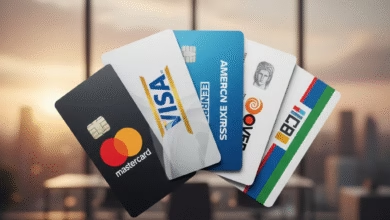7 tips when looking for a credit card
Complete guide to finding the best credit card for you

Choosing a credit card can feel overwhelming. With so many options available, how do you know which one is the right fit for your financial goals and lifestyle? Don’t worry! This guide breaks down the key considerations to help you navigate the world of credit cards and make an informed decision.
1. Understand Your Credit Score: Your Starting Point for Credit Card Approval

Before you even start browsing offers, understanding your credit score is crucial. Your credit score is a three-digit number that reflects your creditworthiness. It significantly impacts the types of credit cards you’ll qualify for and the interest rates you’ll receive.
- Why it matters: A higher credit score generally unlocks access to cards with better rewards, lower interest rates, and more attractive perks.
- How to check: You can obtain free copies of your credit report from each of the three major credit bureaus (Equifax, Experian, and TransUnion) annually at AnnualCreditReport.com. Review your reports for any errors.
- Score ranges: While specific ranges may vary slightly, generally:
- Excellent: 750+
- Good: 700-749
- Fair: 650-699
- Poor: Below 650
Knowing your score will help you target cards you’re more likely to be approved for, saving you time and potential negative impacts on your credit report from multiple applications.
2. Define Your Financial Goals: Are You Seeking Credit Card Rewards or Lower Interest?
What do you hope to achieve with a credit card? Identifying your primary financial goals will help you narrow down your options:
- Earning Rewards: If you spend frequently and pay your balance in full each month, a rewards credit card could be beneficial. These cards offer cash back, points, or miles on your purchases, which can be redeemed for statement credits, merchandise, travel, and more. Consider categories where you spend the most (e.g., travel, dining, groceries) and look for cards that offer bonus rewards in those areas.
- Saving on Interest: If you plan to carry a balance occasionally, a low APR credit card is likely a better choice. These cards offer a lower annual percentage rate (APR) on your outstanding balance, saving you money on interest charges over time.
- Building Credit: If you have a limited credit history or are looking to rebuild your credit, a secured credit card or an entry-level credit card might be a good starting point. Secured cards require a security deposit, which typically acts as your credit limit. Responsible use can help you build a positive credit history.
3. Compare Interest Rates (APRs): Understanding the Cost of Borrowing with a Credit Card

The annual percentage rate (APR) is the annual cost of borrowing money if you carry a balance on your credit card. It’s crucial to understand the different types of APRs:
- Purchase APR: The interest rate applied to new purchases.
- Balance Transfer APR: The interest rate applied to balances transferred from another credit card. Often, there’s an introductory period with a 0% APR.
- Cash Advance APR: The interest rate applied to cash advances, which are typically much higher than purchase APRs and come with additional fees.
- Penalty APR: A higher interest rate that may be triggered if you make a late payment.
Pay close attention to the regular APR and any introductory offers. If you anticipate carrying a balance, prioritize cards with lower ongoing APRs.
4. Scrutinize Fees: Beyond the Annual Fee of a Credit Card
While many credit cards don’t have an annual fee, it’s essential to be aware of other potential fees:
- Annual Fee: A yearly fee some cards charge for membership. Cards with premium rewards often have annual fees, but the benefits can outweigh the cost for frequent users.
- Late Payment Fees: Charged when you don’t make at least the minimum payment by the due date.
- Over-Limit Fees: Charged if you spend beyond your credit limit (though regulations now require you to opt-in to allow over-limit transactions).
- Balance Transfer Fees: A percentage of the amount you transfer.
- Foreign Transaction Fees: Charged when you make purchases in a foreign currency.
Understanding these fees will help you avoid unexpected costs and choose a card that aligns with your spending habits.
5. Evaluate Rewards and Perks: Maximizing Your Credit Card Benefits

If you’re interested in rewards, carefully evaluate the program’s structure and potential value:
- Cash Back: A straightforward reward where you earn a percentage of your spending back as cash.
- Points: Can be redeemed for various options like travel, merchandise, or gift cards. Understand the point values and redemption options.
- Miles: Typically associated with airline or hotel loyalty programs and can be redeemed for flights or accommodations. Consider your travel frequency and preferences.
- Other Perks: Some cards offer benefits like travel insurance, purchase protection, extended warranties, airport lounge access, or concierge services. Determine which perks are valuable to you.
Don’t just focus on the headline rewards rate. Consider the redemption options, any spending caps, and the overall value you’re likely to receive based on your spending patterns.
6. Read the Fine Print: Understanding Credit Card Terms and Conditions
Before applying for a credit card, take the time to read the terms and conditions carefully. This document outlines all the details of the card agreement, including interest rates, fees, rewards program rules, and other important information. Pay attention to:
- Introductory periods: Understand how long any 0% APR or bonus rewards offers last and what the rates or rewards will be after the introductory period ends.
- Variable vs. Fixed APR: Most credit card APRs are variable, meaning they can change based on market interest rates.
- How rewards are earned and redeemed: Understand any restrictions or limitations.
Understanding the fine print will help you avoid surprises and ensure the card aligns with your expectations.
7. Consider Your Long-Term Needs: Choosing a Credit Card for the Future

Think about how your financial needs might evolve over time. While your immediate goal might be balance transfer or earning travel rewards, consider if the card will still be a good fit in a few years. Some questions to ask yourself:
- Will my spending habits change?
- Will I still value the current rewards program?
- Are there cards that could better support my long-term financial goals?
Choosing a credit card is a significant financial decision. By carefully considering these seven tips, you can find a card that not only meets your current needs but also supports your financial well-being in the long run. Take your time, compare offers, and make an informed choice!





